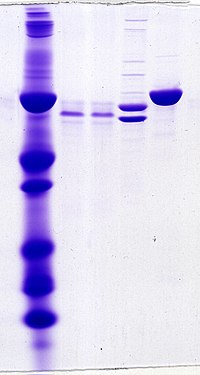
Photo from wikipedia
Background C-X-C motif ligand 13 (CXCL13) and B cell-activating factor (BAFF) are proven to be involved in inflammatory diseases, but their role in allergic rhinitis (AR) remains unclear. The aim… Click to show full abstract
Background C-X-C motif ligand 13 (CXCL13) and B cell-activating factor (BAFF) are proven to be involved in inflammatory diseases, but their role in allergic rhinitis (AR) remains unclear. The aim of this study was to investigate the role of serum CXCL13 and BAFF in AR and their clinical values as objective biomarkers to predict the efficacy of subcutaneous immunotherapy (SCIT). Methods We prospectively recruited 90 children with AR treated with SCIT and collected their serum specimens before SCIT. One-year follow-up was conducted for all patients, and they were categorized into effective and ineffective groups based on efficacy. The serum concentrations of CXCL13 and BAFF were detected and compared between the two groups. A validation cohort of 52 responders and 26 non-responders were further assessed for both cytokines and serum CXCL13 and BAFF levels were assayed by enzyme-linked immunosorbent assay (ELISA). Results Eighty children completed the follow-up schedule, and 56 children were categorized into the effective group and 24 children into the ineffective group. The serum levels of CXCL13 in the effective group were clearly higher than those in the ineffective group (P < 0.05). Receiver operating characteristic (ROC) curves revealed the potential values of CXCL13 as a biomarker in predicting the response of SCIT. Further, in the validation cohort, ELISA results demonstrated that serum CXCL13 levels were increased in responders than non-responders (P < 0.05). ROC curves showed good accuracy of serum CXCL13 in predicting the efficacy of SCIT. Conclusion Our discovery–validation study demonstrated that circulating CXCL13 might serve as a novel biomarker to predict the outcome of SCIT in childhood AR. The findings indicated that CXCL13 was involved in the pathological mechanisms of AR and made help to the fundamental therapeutic mechanism of SCIT.
Journal Title: Frontiers in Pediatrics
Year Published: 2022
Link to full text (if available)
Share on Social Media: Sign Up to like & get
recommendations!